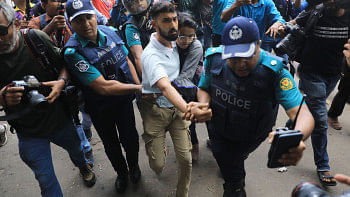Women still lag in mobile ownership, internet adoption

Women in Bangladesh are lagging behind men in both mobile ownership and mobile internet adoption, with gender gaps of 20 percent and 40 percent respectively, representing a significant disparity in digital access, according to a global report.
In Bangladesh, 85 percent of adult males own a mobile phone, compared to 68 percent of adult females.
Meanwhile, mobile internet adoption rates are 40 percent for men and only 24 percent for women, according to Mobile Gender Gap Report 2024 by the GSMA, which represents the interests of mobile operators worldwide.
For those who are already aware of mobile internet, the top-reported barriers to adopting it are affordability (primarily of handsets) and literacy and digital skills, it said.
Millions more women than men face these barriers because they are offline. Women also tend to experience these barriers more acutely due to social norms and structural inequalities, such as lower education and income, according to the report.
The findings of the report are based on the results of an annual GSMA Consumer Survey carried out last year, which had more than 13,600 respondents from 12 low and middle-income countries.
In 10 of the 12 countries surveyed for this report, women who use the internet are more likely than men to access it exclusively on a mobile phone.
For example, in Bangladesh, 74 percent of female internet users access it exclusively via mobile, compared to 66 percent of male users.
In most survey countries, women who use mobile internet are more likely than men to report that they would like to use it more than they currently do.
This was true for more than half of female mobile internet users in Ethiopia, Kenya, Bangladesh, India and Pakistan.
According to the survey, Bangladesh has the highest gender gap in mobile internet adoption among Asian countries at 40 percent.
In comparison, the gap is 30 percent in India, 38 percent in Pakistan, and 8 percent in Indonesia.
Although the gender gap in mobile phone ownership and internet usage in Bangladesh has slightly decreased, it remains substantial.
Gender gaps in smartphone ownership also vary across survey countries and are widest in Pakistan (49 percent), Bangladesh (43 percent) and Nigeria (38 percent).
Women in Bangladesh are also falling behind in smartphone ownership. While 40 percent of men own a smartphone, only 22 percent of women have one.
Fahim Mashroor, former president of the Bangladesh Association of Software and Information Services (BASIS), said most women in the country still rely on men for financial support.
"Typically, if there is a smartphone or laptop in the house, it is mainly controlled by male members. Additionally, parents sometimes restrict girls from using devices or the internet due to social reasons in the still very male-dominated society," he added.
Against this backdrop, he said widespread adoption of the internet by women will remain difficult unless their financial independence is ensured.
Still, women in Bangladesh have seen the strongest growth in mobile internet awareness since 2022, from 64 percent to 74 percent.
For the first time since the GSMA started tracking it, women's awareness in Bangladesh is close to that of men (76 percent), highlighting the progress that has been made.
The report said once women start to use mobile internet, they tend to use it less frequently than men and for a narrower range of services.
At the same time, in most of the survey countries, female mobile internet users are more likely than men to report that they would like to use mobile internet more than they currently do.
This was especially the case for more than half of female mobile internet users in Kenya, India, Pakistan, Bangladesh and Ethiopia.
Affordability is another top barrier to further mobile internet use for both male and female mobile internet users in survey countries.
In most countries, affordability of data is more of a barrier than the affordability of handsets.
Data costs are a particular issue for mobile internet users in Kenya, Nigeria, Uganda and Bangladesh, where it is the top individual barrier to further use for both men and women.
For example, in Bangladesh, 24 percent of women and 15 percent of men who use mobile internet reported data costs as their top barrier to further use.
Overall, women's rate of mobile internet adoption increased over the past year.
There are now more women using mobile internet in low and middle-income countries than ever before: 66 percent.
By comparison, 78 percent of men now use mobile internet, but their rate of adoption slowed in 2023.
The gender gap in mobile internet adoption across low and middle-income countries has narrowed for the first time since 2020 due to women adopting it at a faster rate than men.
This reduction was driven primarily by South Asia and brings the overall mobile internet gender gap back to where it was in 2020.
This gender gap also narrowed slightly in Sub-Saharan Africa for the first time in five years, the report said.

 For all latest news, follow The Daily Star's Google News channel.
For all latest news, follow The Daily Star's Google News channel. 








Comments